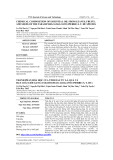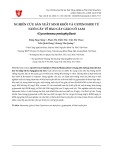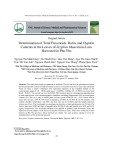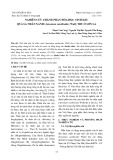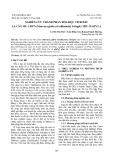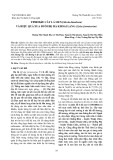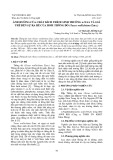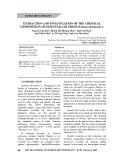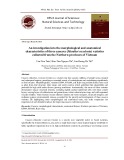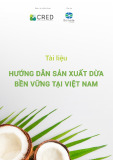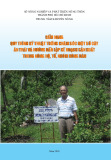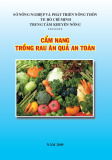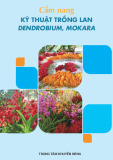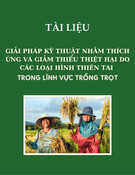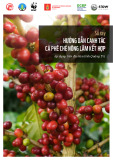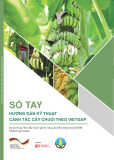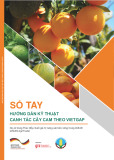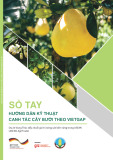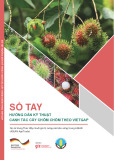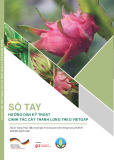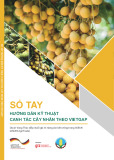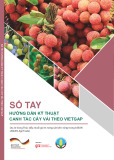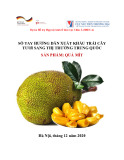
82
TẠP CHÍ KHOA HỌC
Lê Sỹ Bình và cs. (2022)
Khoa học Tự nhiên và Công nghệ
(30): 82 - 88
QUANTIFICATION OF TRACE ELEMENTS
IN TEA LEAVES USING ICP-MS
Le Sy Binh*, Tran Hong Xuan, Tran Thi Mung, Nguyen Thi Thuy An,
Nguyen Thi Dieu Linh, Pham Thi Chuyen, Hoang Hai Long, Giang Thanh Trung
Tay Bac University
Abstract: In recent years, the ICP-MS method has been applied to analyze biological and
environmental samples. The content of several metallic elements, namely Al, Ba, Sr, Mn, Fe, Cu
and Zn in green tea leaves (Camellia sinensis L.) collected from Son La province was analyzed
using the ICP-MS method. The method demonstrated high sensitivity, as indicated by low values
of limits of detection (LOD) and limits of quantification (LOQ). The accuracy of the method was
evaluated through spiked experiments, with values ranging between 89% and 105%. The
distribution of elements in the green tea samples collected from Son La followed the sequence:
Mn > Al > Fe > Zn > Ba > Cu > Sr.
Keywords: Trace element, Son La tea leaves, ICP – MS.
1. INTRODUCTION
Tea, derived from the leaves of Camellia
sinensis L., is the second most consumed
beverage worldwide, following water. Tea
leaves contain a wide range of compounds,
including polyphenols, alkaloids, amino acids,
carbohydrates, proteins, chlorophyll, minerals,
trace elements, and various other compounds
(Chen et al., 2015) [3]. The elemental
composition of tea leaves can be influenced by
several factors, such as the plant's location, plant
variety, fertilizer usage, farming methods, and
storage conditions. Consumption of tea has been
associated with potential benefits in combating
skin cancer, prostate cancer, and lung cancer
(Khan et al., 2013) [9].
Son La is a significant tea-producing
region in Vietnam, particularly known for Ta
Xua tea, an ancient tea variety with high
economic value. Moc Chau, on the other hand,
boasts a large area dedicated to tea cultivation,
with tea trees that have been growing for
several years. Analyzing the elemental content
in tea leaves serves as a basis for assessing tea
quality.
The analysis of metal content in tea samples
has been conducted using various pectroscopic
methods, including flame atomic absorption
spectrometry (FAAS) (Podwika et al., 2018)
[13], graphite furnace atomic absorption
spectrophotometry (GFAAS) (Zhong et al.,
2016) [20], inductively coupled plasma optical
emission spectrometry (ICP OES) (Zhong et al.,
2016) [20], and inductively R coupled plasma
mass spectrometry (ICP-MS) (Hamza et al.,
2021 [5]; Thao N. T. et al., 2018 [17]). Among
these techniques, ICP-MS is widely recognized
as a highly effective method for determining
metal content in samples, offering exceptional
detection capabilities with low detection limits,
as well as superior selectivity and sensitivity.
This technique allows for the simultaneous
determination of multiple elements present in
low concentrations within the samples
(Pasvanka et al., 2021) [11].
The spectroscopic method has been applied
to analyze the metal content in tea samples, such
as flame atomic absorption spectrometry
(FAAS) (Podwika et al., 2018) [13], graphite
furnace atomic absorption spectrophotometry
(GFAAS) (Zhong et al., 2016) [20], inductively
coupled plasma optical emission spectrometry
(ICP - OES) (Pasvanka et al., 2021) [11] and
inductively coupled plasma mass spectrometry

83
(ICP - MS) (Hamza et al., 2021 [5]; Thao N. T.
et al., 2018 [17]). ICP-MS is considered a very
potent discriminant technique regarding metal
content in samples since itprovides high
detection power due to low detection limits as
well as high selectivity and sensitivity. This
technique also provides the simultaneous
determination of several elements present in low
concentrations in the samples (Pasvanka et al.,
2021) [11].
2. MATERIALS AND METHODS
2.1. Reagents and chemicals
All chemical products were purchased from
Merck and were of the highest quality. The
standard stock solutions (1000 mg/L) for the
ICP-MS measurements were obtained from
Merck. De-ionized water (18.2 MΩ-cm) was
sourced from a Milli-Q water purification
system. Glassware was cleaned using a 10%
HNO3 solution and rinsed several times with
deionized water.
2.2. Instrumental analysis
All analyses were conducted using a NexION
2000 ICP-MS instrument (Perkin Elmer, USA)
equipped with an automatic sampling system
operated by a peristaltic pump. The analysis was
carried out employing the Kinetic Energy
Discrimination (KED) mode. The instrumental
parameters for the analysis are presented in
Table 1.
2.3. Sample collection
Fourteen green tea samples were collected
from various tea plantations in Son La province,
Vietnam. The tea samples were obtained in the
form of fresh leaves, including buds and two
young leaves. The tea leaves were first washed
with tap water, followed by a rinse with distilled
water, and then dried at 80°C until a constant
weight was achieved. Subsequently, the dried
tea leaves were ground into a powder and stored
at a low temperature.
Table 1. Operating conditions for the ICP-MS instrument
Parameters
Value
Sample aspiration rate
300 µL/min
Mist chamber (Quartz) temperature
25oC
Mode
Kinetic Energy Discrimination (KED)
Heli gas flow
5.5 mL/min
RF power
1600W
Plasma gas flow
15L/min
Auxiliary gas flow
1.2L/min
Nebulizer gas
1L/min
Nebulizer
PFA
Spray chamber
Glass cyclonic
Sample cone
Nickel sample cone
Cell entrance voltage
-7 V
Cell exit voltage
-32 V
Monitored ion
Sn+ (m/z 118)
Measurement mode
Peak hopping
Dwell time
50 ms
Analytical masses (amu)
27Al, 55Mn, 56Fe, 65Cu, 66Zn, 88Sr, 138Ba
2.4. Sample preparation analysis with acid
digestion
The tea samples underwent acid digestion
prior to analysis. 250 mg of tea sample was
transferred into a 100 mL beaker, followed by
the addition of 5.0 mL of 65% HNO3 solution
and 5.0 mL of 70-72% HClO4 solution. The
mixture was gently heated until complete
decomposition of the sample, resulting in a
moist white salt. After cooling to room
temperature, the sample was dissolved, filtered
through a 0.45 µm filter paper, and brought up

84
to a final volume of 25 mL using 1% HNO3
solution. A blank sample was prepared in a
similar manner, replacing 250 mg of tea with
250 mL of doubly deionized water.
3. RESULT AND DISCUSSION
3.1. Data analytical methods results
To construct a calibration curve, a series of
standard solutions with concentrations of 1 g/L,
5 µg/L, 10 g/L, 25 g/L, and 50 µg/L were
analyzed. The accuracy of the analytical method
was validated by performing quality control
using the standard substances. The Limit of
Detection (LOD) and Limit of Quantification
(LOQ) were calculated using the formulas LOD
= 3.3ζ/S and LOD = 10ζ/S, respectively, where
ζ represents the standard deviation of the
response and S denotes the slope of the
calibration curve.
The results from Table 2 show that, the
LODs value from 0.42 to 5.88 µg/L, the LOQs
value from 4.29 to 17.82 µg/L.
Table 2. Analytical methods results
Element
Slope
Intercept
LOD (µg/L)
LOQ (µg/L)
R2
Al
14.72
32.69
5.88
17.82
0,993
Mn
518.43
201.72
1.48
4.29
0.999
Fe
1314.70
59.99
2.02
6.12
0.999
Cu
1811.90
329.53
0.87
2.64
0.999
Zn
359.90
1599.30
5.22
15.81
0.994
Sr
383.09
– 43.18
1.74
5.27
0.999
Ba
2622.50
41.14
0.42
1.27
1,000
3.2. Recovery
The validity of the proposed procedure
was assessed using the standard addition
method on the MC2 tea sample. Known
amounts of trace elements were added to 250
mg of the tea sample and subjected to
digestion. The recovery of the added trace
elements was calculated using formula (3.1),
and the obtained recoveries ranged from 89%
to 105% (Table 3). The recovery performance
met the satisfactory criteria set by AOAC.
fu
a
100(C - C )
Recovery (%) = C
(3.1)
where Cf: the concentration of fortified
samples, Cu: the concentration of unfortified
samples, and Ca: the concentration of analyte
added to the test sample.
3.3. Sample analysis
The quantification of total elements in tea
leaves was performed using ICP-MS,
employing the operational parameters
specified in Table 1. The distribution pattern
of labile elements analyzed in all green tea
leaves followed the sequence: Mn > Al > Fe >
Zn > Ba > Cu > Sr. This trend aligns with
findings reported by previous authors (Karak
et al., 2010 [8]; Zhang et al., 2018 [19]). The
results are presented in Table 4.
Table 3. Recovery efficiency of the analytical procedure
Element
Added (μg/L)
Total (μg/L)
Recovery (%)
Al
-
28.24
-
5
32.84
92
10
38.05
98
Mn
-
23.59*
-

85
5
28.68
102
10
33.39
98
Fe
-
17.03
-
5
21.83
96
10
27.13
101
Cu
-
16.39
-
5
21.04
93
10
26.29
99
Zn
-
22.39
-
5
27.64
105
10
32.09
97
Sr
-
14.38
-
5
23.38
90
10
23.88
95
Ba
-
8.72
-
5
13.17
89
10
17.82
91
* Samples for analysis of Manganese content were diluted 5 times
Table 4. Analysis of content element in tea leaves (mg/kg)
Samples
Mn
Al
Fe
Zn
Cu
Ba
Sr
MC1
741.92
260.22
61.88
31.85
13.64
13.04
14.95
MC2
1179.39
282.44
85.14
33.58
16.39
4.36
7.19
MC3
1239.37
273.67
86.60
34.69
15.23
11.97
8.40
MC4
923.03
281.94
81.48
31.28
15.58
6.10
7.61
MC5
918.55
201.70
67.41
39.79
14.62
7.04
9.14
MC6
613.33
189.20
65.76
27.67
14.55
12.12
10.56
MC7
576.47
171.43
65.47
35.83
13.04
12.57
6.99
MC8
558.81
185.02
66.17
31.62
14.93
8.00
7.39
BY1
762.75
562.71
61.47
23.99
13.01
26.75
15.50
BY2
554.34
296.06
98.34
31.78
13.68
22.22
11.09
BY3
499.58
206.73
59.37
26.40
14.39
12.60
9.11
BY4
603.27
398.04
72.33
29.45
15.17
22.90
14.92
BY5
629.64
793.67
52.55
20.65
14.28
37.28
34.68
BY6
871.07
433.18
125.32
26.01
12.74
13.26
9.37
Mean
762.25
324.00
74.95
30.33
14.38
15.02
11.92
The manganese content in the 14 green tea
samples collected from Son La province
exhibited a range of 499.58 to 1239.39 mg/kg,
with an average value of 762.25 mg/kg. These
findings are consistent with the results published
by Brzezicha et al. (Brzezicha et al., 2016) [2],
who reported manganese concentrations ranging
from 390 to 1260 mg/kg in 41 samples of
various tea types. However, higher manganese
concentrations were reported by Podwida et al.
(Podwika et al., 2018) [13], with values ranging
from 2210 to 3475 mg/kg in 27 samples of
different tea types.
The aluminium content in green tea from
Son La ranged from 171.43 to 793.67 mg/kg. N.
T. Thao et al. reported that the aluminium

86
content in 10 samples of green tea from Yen Bai,
Vietnam, ranged from 456.97 to 2454.48 mg/kg,
and in 9 samples from Tuyen Quang, Vietnam, it
ranged from 241.23 to 739.61 mg/kg (Thao N.
T., 2018) [17]. The aluminium content in Son La
tea samples was similar to that of Tuyen Quang,
Vietnam, and lower than that of Yen Bai,
Vietnam. In the study conducted by R. Street et
al., the aluminium content in 29 tea samples
from the Czech Republic was higher than the
aluminium content found in this study (Street et
al., 2007) [15].
Iron content in 14 tea samples from Son La
province ranged from 52.55 to 125.32 mg/kg.
The iron content observed in this study was
lower than that reported by R. Street et al., which
ranged from 103 to 523 mg/kg (Street et al.,
2006) [16]. However, the iron levels in this study
were higher compared to other publications
(Jalbani et al., 2007) [7]. Similar findings were
reported by Thao N. T. et al. for 10 tea samples
from Yen Bai province, Vietnam, with a range
of 47.99 to 75.36 mg/kg, and 9 tea samples from
Tuyen Quang province, Vietnam, with a range
of 64.98 to 112.48 mg/kg (Thao N. T. et al.,
2018) [17].
Zinc is a crucial trace element that plays a
vital role in numerous structural proteins,
enzymatic processes, and transcription factors. It
is involved in various functions, including cell-
mediated immunity, bone formation, tissue
growth, brain function, as well as the growth of
the fetus and child (Bagherani et al., 2016) [1].
In this study, the zinc content ranged from 20.65
to 39.79 mg/kg, which was higher than the zinc
content reported in six Japanese green teas by
Islam et al. (range 14.7 – 26.4 mg/kg) (Islam et
al., 2012) [6]. Similar zinc content was also
reported by H. Deka et al. in Indian tea samples,
with a range of 20.2 – 35.1 mg/kg and a mean of
26.79 mg/kg (Deka et al., 2021) [4].
Copper is vital for essential life processes
such as energy metabolism, detoxification of
reactive oxygen species, iron uptake, and
signaling in eukaryotic organisms (Ruiz et al.,
2021) [14]. In the Son La tea samples, the
copper content ranged from 12.74 to 16.39
mg/kg, with a mean of 14.38 mg/kg. The copper
content observed in this study was lower than
that reported by Deka et al. (Deka et al., 2021)
[4] (13.4 – 22.73 mg/kg) and Street et al. (Street
et al., 2007) [15] (9.0 – 65.0 mg/kg for the group
of 30 samples). A lower mean copper content of
8.18 mg/kg was published in the study
conducted by Yao et al. (Yao et al., 2022) [18]
for Tieguanyin Tea samples from Fujian, China.
The content of barium (Ba) in the tea
samples from Son La ranged from 4.36 to 37.28
mg/kg, with a mean value of 15.02 mg/kg. The
barium content in Moc Chau tea samples was
lower compared to that in Bac Yen tea samples.
The barium content in this study was similar to
the value reported by Pinto et al., which was
16.63 mg/kg (Pinto et al., 2020) [12]. However,
the barium content in this study was lower than
that found in 10 samples of Yen Bai tea,
Vietnam, which ranged from 13.42 to 57.66
mg/kg (Thao N. T. et al., 2018) [17].
The content of strontium (Sr) in this study
ranged from 6.99 to 34.68 mg/kg, with a mean
value of 11.92 mg/kg. The strontium content in
the 14 samples of Son La tea was lower than that
in samples consumed in Senegal, which ranged
from 20 to 90 mg/kg (Mbaye et al., 2013) [10].
4. Conclusion
The ICP-MS method was utilized to
simultaneously analyze the elemental
composition of tea leaves collected in Son La.
This method demonstrated a LOD and LOQ,
along with a satisfactory recovery efficiency of
93% to 105%, meeting the requirements for
trace analysis. The distribution of elements in the
green tea samples followed the sequence: Mn >
Al > Fe > Zn > Ba > Cu > Sr. These findings are
consistent with previous publications on the
subject.
Acknowledgements


